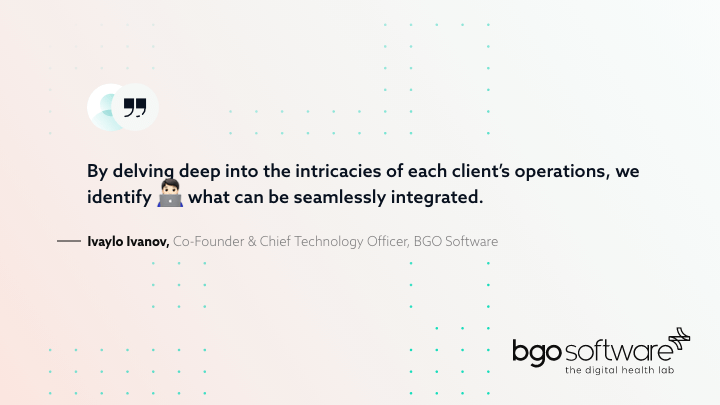To build or not to build new software? To buy or not to buy? That is the question! Indeed, this is one of the biggest dilemmas facing business owners, technical leaders, and business executives. The dilemma becomes even more challenging when considered within the healthcare context.
However, we are fortunate to have our CTO with us, sharing his wealth of experience. With more than 23 years in the IT industry, including 15 years in the digital health space, Ivaylo Ivanov has met numerous leaders and companies.
Based on that, in this article, he delves into the decisions healthcare organizations make in their quest for the most suitable software solution for their challenges.
Ivaylo believes that the choice between off-the-shelf and custom-made software solutions has profound implications. This is because it influences the efficiency, versatility, and competitive edge of healthcare organizations, including yours.
By weighing the pros and cons of both options, he aims to provide insights that will help your organization make more informed decisions, ensuring that you meet your specific needs. Let’s take a closer look.
Tech choices in healthcare: off-the-shelf vs custom-made software pros and cons
Custom-made solution
When your healthcare organization’s functionality aligns with your vision, investing in custom-made software is essential. This approach is particularly helpful when your organization is already functioning and has a firm structure.
We believe that the customization component of the custom-made solution becomes significant when you want to automate your organization’s operational methods into a software solution.
To benefit from the custom solution, your team needs a systematic approach. According to Ivaylo, it’s crucial to understand the system comprehensively. The purpose of a tailored solution is to digitize and automate processes entirely. That allows the system to remain flexible and meet your healthcare organization’s changing requirements as new challenges arise.
Off-the-shelf solution
In the domain of off-the-shelf solutions, you’re essentially integrating a readymade response into your own operational model. You begin with a solution crafted as the best approach for a particular problem that has been previously applied by another company. Subsequently, customization is essential to align it with your organization’s requirements and your team’s readiness to utilize it.
“This involves adapting your organization to utilize the off-the-shelf practice. It happens when you identify a problem resolved for another organization, and you align your organization with that proven solution.”
Ivaylo Ivanov, Co-Founder & Chief Technology Officer, BGO Software
One of the significant drawbacks of off-the-shelf solutions emerges during implementation, where organizations often face a roadblock. This occurs when the solution cannot be tailored to meet a specific aspect or need of the organization. This stands as a significant challenge, particularly when your organization cannot compromise or adjust its structure to fit a solution that cannot be customized.
Evaluating client needs: BGO’s proven formula for helping you choose between off-the-shelf and custom solutions
Time to deploy
“Pre-existing solutions, optimized for specific problems, often offer quicker deployment, aligning with time-sensitive client requirements.”
If you find yourself caught in the dilemma of choosing between off-the-shelf and custom solutions, BGO offers essential guidance to navigate this complex decision-making process. One of the pivotal considerations revolves around the urgency with which you require your organizational goals to be achieved.
Speed is a critical determinant, influencing the suitability of an off-the-shelf solution for your needs. It’s our job to understand the urgency of your problem and to assess the time to deploy the solution you need. We have found that if the rapid implementation is imperative for your objectives, then deploying an off-the-shelf solution might be the most beneficial route.
Evaluating the cost of ownership and maintenance
Another pivotal aspect of your decision-making process should be the cost of ownership. While off-the-shelf solutions are convenient for immediate deployment, the long-term expenses can be prohibitive. You need to consider the feasibility of adopting and maintaining these solutions within your organizational framework.
“Off-the-shelf solutions often incur steep costs, not just during implementation but also in the form of ongoing maintenance fees.”
The challenge arises from the high expenses associated with adapting these solutions to various facets of your business. These substantial fees might render the solution less profitable and accessible for you and your organization in the long run, prompting an inevitable reevaluation of the initial decision.
Organizational preparedness
Beyond deployment and cost considerations, we focus on the importance of organizational preparedness and proficiency. We believe that this is a crucial factor in successfully integrating any solution is the internal capacity of your organization.
That’s why it’s important to evaluate your existing workforce by examining how many individuals possess the necessary qualifications to train others, operate the solution proficiently, and maintain its functionality.
If your organization lacks internal expertise for these tasks, you face the risk of investing in a solution without fully capitalizing on its potential benefits. In such cases, you might pay for the solution but fall short of reaping its complete advantages, highlighting the significance of thorough internal preparation and organizational alignment.
Our approach is not merely about providing solutions but understanding the nuanced requirements of your business. By evaluating the urgency, cost implications, and organizational preparedness, we ensure that you make informed decisions tailored to your unique needs, optimizing the outcomes of your technology investments.
Is investing in new software a business or a technical decision?
The question of whether investing in new software is primarily a business or a technical decision often looms over many organizations. However, for us at BGO, it stands as a pivotal business decision with far-reaching implications for an organization’s growth and operational efficiency.
A business decision with strategic implications
When evaluating new software, it’s essential to see it as a strategic business move. This perspective significantly shapes your organization’s direction. To make a well-informed decision, focus on financial considerations. Assess your budget carefully and prepare for unforeseen costs that might arise during implementation.
The time it takes for software to become operational is another key factor. If a software solution takes more than five years to provide substantial benefits, it might warrant exploring an alternative approach. In such instances, choosing a custom-made solution can not only be faster but also more cost-effective for your organization.
Customized software, designed to address your specific needs, not only enhances operational efficiency but also guarantees financial prudence.
The role of technical expertise
Although business considerations primarily guide the decision-making process, effective implementation requires technical expertise. Technical decisions are pivotal for the seamless integration of software into your organizational structure.
In the short term, according to Ivaylo, hiring a knowledgeable consultant can fill the technical gaps. However, long-term success necessitates a permanent, in-house expert. This dedicated professional not only ensures smooth implementation but also guarantees that the software evolves in line with your organization’s changing needs and objectives.
In essence, the decision to invest in new software is undeniably a business decision, intricately intertwined with your organization’s growth strategy and financial health. However, acknowledging the critical role of technical expertise is equally vital for the successful implementation and long-term effectiveness of the chosen software solution.
Three things to keep in mind when making the decision
1. Understanding hidden costs
Beyond the initial investment, a comprehensive analysis of the cost of ownership is essential. Uncover hidden expenses such as updating costs as your organization expands, taxes, and maintenance fees. Anticipating these expenditures ensures a clear financial picture and prevents unexpected financial strains down the road.
2. Planning for future needs
“Understanding your business’s long-term strategy is crucial.”
Anticipate the requirements your organization will have to thrive in the future. This could involve expanding into countries with diverse operational models and data processing methods.
If you plan to hire more staff, consider how they will adapt to both new software and existing integrated systems. Proactively addressing these factors empowers you to select software that harmonizes with your evolving needs, promoting seamless growth and adaptability.
3. Embracing digital evolution
Today businesses must prioritize modernization to sustain success. Digitalization has become integral over the last decade. In our experience, custom-made solutions are often better designed to cater specifically to your needs and can offer you a strategic advantage over the competition.
This happens because they not only ensure user-friendly experiences but also position your organization at the forefront of technological innovation, contributing significantly to your company’s value proposition.
Consultations play a pivotal role in discovering your needs and the appropriate software solution. While planning the integration of an off-the-shelf product, our experts at BGO remain open to the possibility of future modifications. These alterations can transform an existing product into a seamless fit, tailored precisely to your requirements.
Navigating software solutions
When you approach us seeking guidance on their software development strategy, our approach extends beyond mere consultation. We are likely to find that what you require isn’t an intricate custom solution but a fitting off-the-shelf software.
Take, for instance, a hypothetical company desiring efficient client information and offer management, which are tasks effortlessly handled by a simple CRM system. However, complexities arise when the organizational structure deepens and that demands a more nuanced approach.
The significance of custom-made solutions
In the realm of large enterprises, the focus sharpens on seamless integration. The critical consideration revolves around how the new software aligns with existing processes, aiming to eliminate redundant data entry.
For these intricate cases, our recommendation leans towards custom-made software. Unlike off-the-shelf solutions, custom software ensures complete harmony, integrating effortlessly with all existing systems and processes within your organization.
Unveiling long-term needs
The essence of our discovery calls and onboarding process lies in uncovering the profound, long-term needs of your organization. It’s not just about what’s possible in the immediate scope, but what can be envisioned for the future.
We also figure out the parts of the software solution that require modification and might necessitate a bespoke solution. These interactions serve as the cornerstone of BGO’s consulting strategy as we forge a path that aligns technology with the unique demands of every organization that we help.
Three reasons to choose a custom-made software solution
1. Competitive advantage
Custom-made software can be meticulously crafted and adapted to significantly enhance the value of your business. In an arena where standardized tools are accessible to everyone, having a solution specifically catered to your objectives empowers your organization to outshine competitors. It positions you strategically, fostering accelerated growth and providing the upper hand in your industry.
2. Minimizing opportunity costs
Off-the-shelf solutions often lack crucial features, leading to missed opportunities and potential client losses. These opportunity costs can far exceed the apparent savings of pre-packaged software.
Custom solutions bridge this gap by ensuring your software not only meets but exceeds your operational needs. By addressing these nuances, custom software becomes an investment that saves money over time, boosting your revenue potential and maximizing profitability
3. Staying ahead of economic shifts and innovations
Off-the-shelf solutions, once purchased, might not keep pace with your organization’s growth or the changing global landscape. Custom-made software, on the other hand, offers the agility needed to navigate economic shifts and innovations swiftly.
Your software can be updated and tailored in real-time, ensuring your business remains at the forefront of industry developments. This adaptability not only future-proofs your operations but also positions your organization as a trailblazer, ready to embrace change and capitalize on emerging opportunities.
The choice between off-the-shelf and custom-made software solutions demands careful consideration. Each option carries its own set of advantages and challenges. It’s essential to grasp your organization’s unique needs. Weighing customization benefits enables you and your team to harness technology fully, ensuring seamless operations and a competitive advantage for your organization.


















